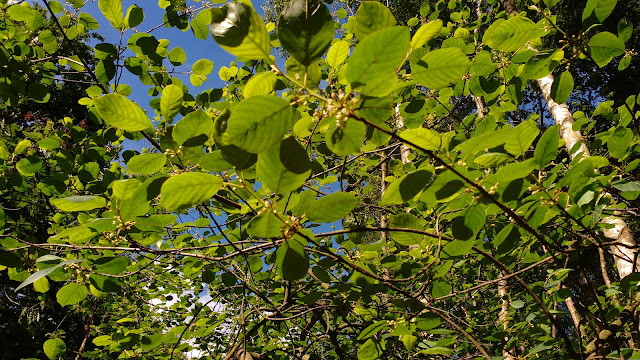 It's been a bit of a race trying to protect as many of the emerging oaks and beech as possible before they are eaten by deer. We've protected 75 so far with our recycled tree tubes and home made stakes. We have to be fast. A seedling beech was marked with one of our red painted stick markers but not covered immediately. Returning to it a short time later with a tree tube and stake, it had already been been eaten - stripped of its foliage leaving a bare twig behind. The other day Sarah looked up from banging a tree stake in, to see a heavily pregnant doe staring at her through the bracken. A quick snap with a mobile phone got a picture of the culprit. The deer at this time of the year are usually single does.
It's been a bit of a race trying to protect as many of the emerging oaks and beech as possible before they are eaten by deer. We've protected 75 so far with our recycled tree tubes and home made stakes. We have to be fast. A seedling beech was marked with one of our red painted stick markers but not covered immediately. Returning to it a short time later with a tree tube and stake, it had already been been eaten - stripped of its foliage leaving a bare twig behind. The other day Sarah looked up from banging a tree stake in, to see a heavily pregnant doe staring at her through the bracken. A quick snap with a mobile phone got a picture of the culprit. The deer at this time of the year are usually single does.
Though the deer browse a great deal at ground level, they also tear off and eat tree bark. However they do not appear to cause such excessive damage that squirrels wreak on trees, particularly beech. This summer has been particularly bad. The mild winter of 2015 - 2016, with plenty of available food and seemingly no need to hibernate, appears to have led to a squirrel population explosion. We've never seen so much damage to our beech trees. They rip the bark off from the base to the top of the tree, seeking the sweet layer directly under the bark. We have tried protecting trees from deer, by piling branches and other brash around the tree stem. Though this seems to have some deterrent effect, nothing stops the squirrels. who just climb further up the tree and start stripping the bark there. The effect of this is to slow the growth of the tree, and if it is so bad that the bark is stripped off all round the trunk - effectively ring barking it - then the tree will die.
The culprit of this vandalism is not the small pretty, native red squirrel (sadly now only found in isolated pockets in the UK) but the larger, immigrant American grey squirrel (Scirius caroliniensis) These are native to North America and were first released in the UK in 1876 in Henbury Park Cheshire. They soon spread throughout the country.
 |
| Red squirrel (library picture) |
We wondered if it might be possible to paint some sort of a deterrent on the tree trunks, but it seems not. It would be wonderful if both the deer and squirrels stuck to eating birch, bracken, bramble and grass. There's plenty of that to feed them , and would make our work so much easier. However, like us, it seems that both animals like a varied diet, and the cambium layer which lies underneath the bark is a great treat for them. Bark stripping is at its height from April to July, and after this the activity falls off markedly., and the tree will have some months to try and repair the damage. Once the tree grows larger, squirrels lose interest. So, if pest control doesn't work, though that's something we will try, it looks as if we'll just have to live with it, and hope that we can grow enough beech trees , healthy enough to resist grey squirrel damage.
Sometimes, this sort of dispiriting battle with woodland pests can make the restoration of 30 acres of woodland feel like an uphill struggle. We put in two regular working days a week at Old Copse throughout the year, and are fortunate to have occasional help from our deer stalkers, and a volunteer or two. We also make good use of child labour when it is available. Bracken bashing is an excellent job for kids - an easy , light and satisfying activity with instant results. So, it's important to remain optimistic, and to remind ourselves of what we've achieved during the past 7 years, despite all the difficulties, and appreciate how much our hard work has transformed Old Copse.
Latest sightings: fallow deer (see above), a pair of wrens with 3 fledglings, making good use of a brash pile to raise their young family, a pair of marsh tits, 4 speckled wood butterflies on the bluebell walk, many bees busy in the alder buckthorn.
 |
| Alder buckthorn in flower - a bee magnet |






